
The Paris Commune was a French revolutionary government that seized power in Paris from 18 March to 28 May 1871.
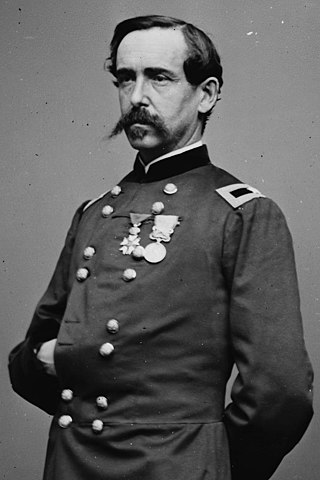
Gustave Paul Cluseret was a French soldier and politician who served as a general in the Union Army during the American Civil War, and Delegate for War during the Paris Commune.
The Hague Congress was the fifth congress of the International Workingmen's Association (IWA), held from 2–7 September 1872 in The Hague, the Netherlands.

The International Alliance of Socialist Democracy was an organisation founded by Mikhail Bakunin along with 79 other members on October 28, 1868, as an organisation within the International Workingmen's Association (IWA). The establishment of the Alliance as a section of the IWA was not accepted by the general council of the IWA because, according to the IWA statutes, international organisations were not allowed to join, since the IWA already fulfilled the role of an international organisation. The Alliance dissolved shortly afterwards and the former members instead joined their respective national sections of the IWA.
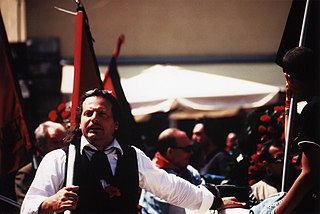
Anarchism in France can trace its roots to thinker Pierre-Joseph Proudhon, who grew up during the Restoration and was the first self-described anarchist. French anarchists fought in the Spanish Civil War as volunteers in the International Brigades. According to journalist Brian Doherty, "The number of people who subscribed to the anarchist movement's many publications was in the tens of thousands in France alone."
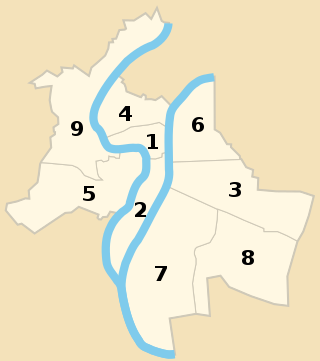
The nine arrondissements of Lyon are the administrative divisions of the City of Lyon. Unlike the spiral pattern of the arrondissements of Paris, or the meandering pattern of those in Marseille, the layout in Lyon is more idiosyncratic. This is for historical reasons: following the annexation of the communes of La Guillotière, La Croix-Rousse and Vaise in 1852, the newly enlarged city was divided into 5 arrondissements, which originally spiralled out anticlockwise from the Hôtel de Ville ; however, as the city's population expanded, it became necessary to split certain arrondissements, giving rise to today's seemingly random pattern.

The Canut revolts is the collective name for the major revolts by Lyonnais silk workers which occurred in 1831, 1834 and 1848. They were among the first well-defined worker uprisings of the period known as the Industrial Revolution.

The Rue Lanterne is one of the oldest streets of Lyon, created in the Middle Ages, which is located in the 1st arrondissement of Lyon. It begins after the rue d'Algérie and ends against a facade of the rue Longue.
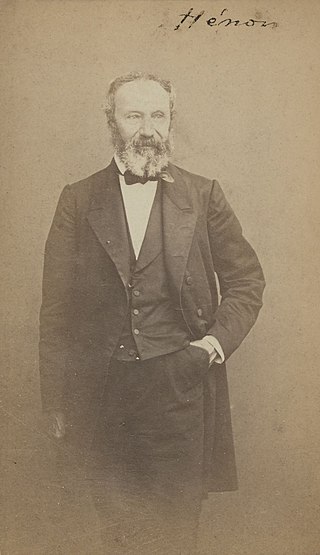
Jacques-Louis Hénon was a French republican politician. He was member of the Corps législatif in 1852 and from 1857 to 1869. He was the mayor of Lyon from 1870 to 1872.
A workers' council, or labor council, is a type of council in a workplace or a locality made up of workers or of temporary and instantly revocable delegates elected by the workers in a locality's workplaces. In such a system of political and economic organization, the workers themselves are able to exercise decision-making power. Furthermore, the workers within each council decide on what their agenda is and what their needs are. The council communist Antonie Pannekoek describes shop-committees and sectional assemblies as the basis for workers' management of the industrial system. A variation is a soldiers' council, where soldiers direct a mutiny. Workers and soldiers have also operated councils in conjunction. Workers' councils may in turn elect delegates to central committees, such as the Congress of Soviets.

The International Workingmen's Association (IWA) in the United States of America took the form of a loose network of about 35 frequently discordant local "sections," each professing allegiance to the London-based IWA, commonly known as the "First International." These sections were divided geographically and by the language spoken by their members, frequently new immigrants to America, including those who spoke German, French, Czech, as well as Irish and "American" English-language groups.

The International Workingmen's Association (IWA), often called the First International (1864–1876), was an international organisation which aimed at uniting a variety of different left-wing socialist, social democratic, communist and anarchist groups and trade unions that were based on the working class and class struggle. It was founded in 1864 in a workmen's meeting held in St. Martin's Hall, London. Its first congress was held in 1866 in Geneva.

Guillotière Cemetery is the name of two adjacent but associated cemeteries in Lyon, France. The two cemeteries are distinguished according to when they were built: the new cemetery was built in 1854 and the old cemetery in 1822. They are situated in the La Guillotière neighborhood of the city, in the 7th and 8th arrondissements, just south of Parc Sergent Blandan. They were built to address the shortage of burial spaces in the city. The old cemetery is just north of the new cemetery, and the two are separated by Avenue Berthelot and the railroad tracks connecting Perrache and Part-Dieu railway stations. The new cemetery is the largest in Lyon at 18 hectares.
This chronology of the Paris Commune lists major events that occurred during and surrounding the Paris Commune, a revolutionary government that controlled Paris between March and May 1871.

The Besançon Commune was a short-lived revolutionary movement conceived and developed in 1871, aiming at the proclamation of a local autonomous power based on the Lyon and Paris experiences. It originates from social upheavals which metamorphosed the city and with the emergence of unions including a section of IWA in connection with the future Jura Federation. The course of events was precipitated by the Franco-Prussian War, the fall of the Second Empire, and the advent of the Third Republic. While many notables testify to an insurrectionary context and armed support from Switzerland being organized, the correspondence left by James Guillaume and Mikhail Bakunin attest to a planned release between the end of May and the beginning of June 1871. However, with the start of the Semaine sanglante on 21 May and the pursuit of an internal campaign until 7 June, any attempt was seriously compromised. Despite the hope of a restart, in the following weeks and months the idea of an insurrection was definitively abandoned, later reinforced by the extinction of groups and activities described as "anarchist" from 1875.
Anarchism in Switzerland appeared, as a political current, within the Jura Federation of the International Workingmen's Association (IWA), under the influence of Mikhail Bakunin and Swiss libertarian activists such as James Guillaume and Adhémar Schwitzguébel. Swiss anarchism subsequently evolved alongside the nascent social democratic movement and participated in the local opposition to fascism during the interwar period. The contemporary Swiss anarchist movement then grew into a number of militant groups, libertarian socialist organizations and squats.
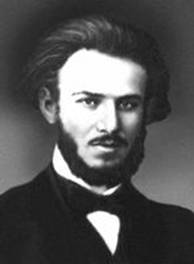
Nikolai Isaakovitch Utin was a Russian socialist and revolutionary. He grew up in Saint Petersburg, and became a charismatic leader of the student movement. Because of his revolutionary activities, he spent most of his adult life in political exile in Switzerland, where he participated in the founding of the Russian section of the International Workingmen's Association and kept up correspondence with liberals and revolutionaries across Europe. In the conflict between Mikhail Bakunin and Karl Marx, he supported Marx, and through his involvement with Geneva journals Narodnoye delo and l'Égalité as a writer and editor, he played an important role in increasing support for Marx at Bakunin's expense. He was extremely influential in revolutionary circles until the breakup of the First International in 1876, whereupon he withdrew from politics and returned to Russia.

The Federated Legion of Women was an armed unit composed of women active during the Paris Commune in May 1871. It was founded in the 12th arrondissement, with the intended mission of hunting down deserters. The legion had uniforms, parades, and a standard-bearer, and was led by two officers, Colonel Adélaïde Valentin and Captain Louise Neckbecker. There were an estimated 20-100 members, most from working-class backgrounds. They held and attended meetings in Parisian political clubs, where they incited citizens to take up arms. After the defeat of the Commune, arrested members were given heavy sentences, including forced labour and deportation.
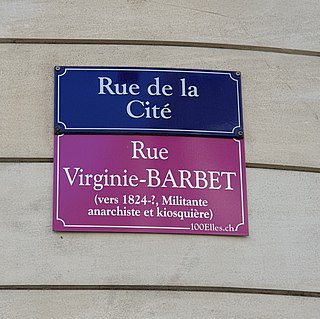
Virginie Barbet (1824–1883) was a French anarchist and feminist. A proponent of social democracy in Lyon in the late 1860s, she joined the International Alliance of Socialist Democracy with Mikhail Bakunin and participated in the Lyon section of the First International. She and other Lyon exiles lived in Geneva during the 1870s.


















